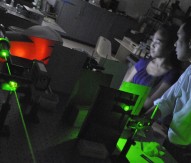

© Marc O'Sullivan Photography
Intel: UX and Photonics
Justin Rattner is the Chief Technology Officer of Intel Corporation and Managing Director of Intel Labs, overseeing the company’s research and development into new products, including processors, communications and user experience and interaction.
Speaking to Pan European Networks at the ‘Open Innovation 2.0’ conference at Dublin Castle, Ireland, Rattner outlined Intel’s key future developments.
Benchmarked in our market by well over a dozen companies comparable to the size to Intel, companies with a revenue in the tens of billions of dollars, we felt it was important that a fraction of our research dollar had to go into ‘delivering’ a pipeline of technologies to our business units. The units need to be fed with a constant stream of new technology, to feed their innovation processes.
We decided half of every dollar goes into what we call ‘directed research’, research that we know from the outset is destined to go into our server business, for example. The other half of every dollar goes into ‘exploratory research’, where there may or may not be an obvious connection to the business. I think this 50/50 split really gives us the flexibility we need to tackle new things as well as maintain a very steady pipeline of new technologies.
User experience
More than a decade ago, we began hiring ethnographers, social anthropologists, even behavioural economists, with the understanding that in the long-term we were going to need a much deeper understanding of people-related technology and how people would see technology changing their lives, hopefully for the better.
Recently we have focused a lot on this notion of user experience, something we call ‘UX’. Over the last few years, Intel Labs’ research has really convinced the corporation to rethink its product development practices to incorporate the notion of experience-driven design from the start and then maintain it throughout the R&D process. For example, considering power consumption, if you started out with a 100MW processor and you get to the end and it’s still a 100MW processor, you need to make sure that throughout the product’s development, the features and the capabilities which enable certain user experience actually reaches the market, that it’s in the product from the beginning to the end. We are currently developing ‘free me’, which is getting rid of all the wires for PCs. At some of the early meetings, the developers said that we can get rid of all the wires, but two (the power connection and USB); but I said this is ‘free me’ – no wires!
Over the last year, we have been able to take an experience and break it down into what it’s required to do, almost to the point that an individual programmer or hardware designer can see what they’re doing in the lowest levels of the design, but can still walk back up the tree and to see how that enables experience. We had to figure out how to expand the tree so developers can see the whole process. We’re there now and I think that’s a profound change for Intel.
Photonics
Photonics is our first venture out of Intel Labs. About two years ago, myself, Paul Otellini, our just-retired chief executive officer, and Stacy J Smith, our chief financial officer, discussed that there were technologies, mostly on the exploratory side, that don’t have an obvious home. You don’t want these technologies to just be left behind, so we decided to have a business venture centred on those technologies, and silicone photonics was one of the first.
We had a decade’s worth of research as well as a substantial amount of US Federal Government funding, and we were finally ready to make decision; either go into production or go and try something else. It’s our first venture and we will have products on the market within a year. We’ve had engineering samples out on the market already and we think it is just going to transform the data centre. Originally, we thought it would be the technology that interconnected the racks in the data centre, yet companies, such as Facebook, said ‘no, given what it can do and its cost effectiveness and energy efficiency, we want to bring it into the rack’. So now we’re talking about photonic rack architecture – every tray in the rack is linked photonically, as opposed to electronically, and that’s a huge change.
I’ve talked about photonics in Europe for the last half dozen years and I think Europeans look at this area differently, considering it more as a metropolitan area technology and network – they don’t consider it technology for the data centre. Yet American companies, Chinese companies, Asian companies definitely do and are moving quickly. The interest in Europe is primarily of high performance computing, not broader opportunities in the data centre.
Justin Rattner






